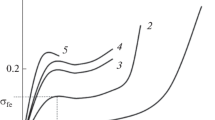Abstract:
We have used a new experimental method to produce and deform three-dimensional monodisperse foams. Uniaxial deformation causes transitions in the foam in which the number of close-packed bubble layers perpendicular to the direction of elongation changes by one. We predict the critical strains at which such transitions occur by calculating the foam energy as a function of strain. These calculations are approximate with simplifying assumptions regarding the geometry of the bubbles. The foam deforms by nucleation and subsequent glide of dislocations which consist, in one configuration, of pairs of 12- and 16-faced cells along a close-packed direction of the foam. We describe these line defects and identify the topological transformations that occur in glide. These are neighbour switchings associated with a 4-sided face that rotates changing the adjacencies of the cells. These T4 operations occur in an avalanche and cause movement of the dislocation while preserving its identity.
Similar content being viewed by others
Author information
Authors and Affiliations
Additional information
Received 16 July 2001
Rights and permissions
About this article
Cite this article
Rosa, M., Fortes, M. & Vaz, M. Deformation of three-dimensional monodisperse liquid foams. Eur. Phys. J. E 7, 129–140 (2002). https://doi.org/10.1140/epje/i200101100
Issue Date:
DOI: https://doi.org/10.1140/epje/i200101100




